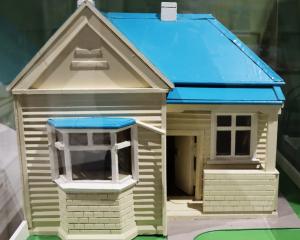A Dunedin artist's "full-on" commemoration of land girls was born out of respect for their wartime efforts, writes Shane Gilchrist.
Jai Hall has gone to some lengths to honour the contribution New Zealand land girls made during World War 2.
Having painstakingly forged 16 bells out of bronze, the Otago Polytechnic Dunedin School of Art honours student plans to install them outside woolsheds on farms around New Zealand.
Some places have been chosen specifically because of their connection with former land girls, while others, though not directly linked to land girls, are significant enough to warrant inclusion, Hall says.
''I've gone for utopian places, such as Erewhon, Molesworth Station, Waitai Station on D'Urville Island, as well as Stonehenge or Patearoa Station in the Maniototo,'' she says, adding, ''The stories the remaining land girls have to tell are of historical significance.''
In placing the bells outside woolsheds, Hall hopes to educate a ''wider audience'' on the significance of the New Zealand Women's Land Service's contribution to both society and the war effort between 1939-1946, when it was disbanded.
Hall describes the process of making the bells as ''full-on''. It involved packing moulding sand at the Dunedin School of Art foundry ''on some of the coldest days in winter''. Molten bronze was then poured into each mould. On cooling, the cast bells were ground, sanded and polished. Each bell has a detail of the New Zealand Women's Land Service badge and is inscribed with the words: ''We only did what was expected. We just got on with it.''
Hall says she chose bronze because ''it is permanent, but also because during wartime, bronze bells were melted to make cannons, and during peacetime, cannons were melted to make memorials''.
''I got the pattern - it's like a ship's bell - from the Robinson Bell foundry in South Dunedin.''
The bells were also part of a recent exhibition by Hall, ''Land Girl Project: A Forgotten Story'', which included a range of sketches, quotes and written installations in the form of zines (a form of budget publication). At this point, Hall has set herself the goal of having each bell placed on site by Anzac Day 2013.
Hall admits she is a relative newcomer to the subject of the New Zealand Women's Land Service.
''I read Dianne Bardsley's book, The Land Girls: In a Man's World, 1939-1946, in 2000. That was the kernel of the idea. I didn't know about the land girls until I read that book.
''I'm not a New Zealander - I'm from Western Australia - and when I first came here I leased a property on the Maniototo in the late 1980s. Someone gave me the book and it prompted me to start drawing some of the land girls and their quotes. The more I read it, the more I thought how amazing it was.
''I already had a bachelor of fine arts degree but I went back to the Otago Polytechnic and told the head sculptor what I wanted to do. So I enrolled in the honours year for 2012.''
Time is of the essence, she says.
''A lot of these women are in their late 80s. I've spoken to six, all of whom are bright as a button. They all said the same thing: `We just got on with it'.''
Sadie Leitze was another who just got on with it.
Mrs Leitze (nee Stuart), who has lived in West Otago for much of her 89 years, was working at the Tip Top milk bar in the Octagon, Dunedin, when she answered the recruiter's request to join the New Zealand Women's Land Service in 1942.
''We went to help our soldier friends who had gone to war.
''I was 19 when I moved to Tara Hills Station, near Omarama. I'm now coming up to 90.''
Mrs Leitze, who spent her first 15 years at Highcliff, asked to work on a dairy farm because she was used to dealing with cows. However, she was sent to a sheep station, where she stayed for two years.
''Those two years of my life didn't have too many bright spots - it was just work, work, work. I was with a man and a woman, who had four children. I got on very well with them all. There had been two land girls before me but they didn't stay. However, I made up my mind that I would stay.
''I looked after the four ponies that the children used to ride to school. I milked the cows, made the butter, all kinds of things. I also used to help break in horses.
''Rabbiting was the main thing; I'm very good at catching rabbits. I used to touch the carrots, which had poison on them, but I'm not dead yet ... We would gut them and hang them in pairs on the gate; they went to Pukeuri, where they were tinned and sent to England as food.''
Living conditions were fairly basic, Mrs Leitze recalls.
''I lived in a hut. There was no power, but I was allowed into the house to have a bath once a week. We were issued with work clothes, but my clothing didn't arrive at the farm when I did. I went in July, when it was very cold.
''After two years, I asked for a transfer and was sent to Kelso. When I got to Kelso, there wasn't a horse in sight. That was the only thing I missed. I stayed with a lovely family for six months. I slept in the house and there were plenty of young people around.
''I met lots of lovely people. That's where I settled. My husband had just come out of the army.
''I left the land service in 1946 and married Bill the same year. I'm still in the area. We retired to live in Tapanui.''
Sadie's story is hardly unique. Women aged 17 and over, from all walks of life, filled roles ranging from musterer, blacksmith, fencer, and rabbiter to tractor driver. According to a National Service Department parliamentary report, 3300 women had been directed into farming by the end of World War 2.
Yet there is no formal or official register of those who were in the New Zealand Women's Land Service. While the women provided an essential war service, the only records of their efforts are those they kept themselves, along with badges, handbooks, clothing and photographs.
''National Archives held no records of their service,'' says Dianne Bardsley, whose book was published by Otago University Press in 2000.
Bardsley says she was motivated by the desire to create a record of events and experiences where none had previously existed.
''I had grown up in a country area where land girls were employed and it was obvious that there was something special about them. I wrote the book after writing wartime plays for secondary school students, realising that the land-girl story was an extraordinary untold story.
''They were like Cinderellas, really - they did so much work, raising rural production to record levels after 28,000 men left the rural world to serve overseas.''
In her book, Bardsley notes land girls were virtually forgotten after World War 2. The Women's Land Service was caught between the auxiliary services (WAACs, WAAFs and Wrens) and the civilian world and so was exempt from the need to pay gratuities and benefits to its former members.
''These women achieved so much in terms of demonstrating that women were equal to men both in farm and stock management and all the physical aspects of a farm.
''But the sad thing was that men came back and took up their roles again and many husbands did not want their wives to be seen driving a tractor and doing physical work. It dented their pride, and the women in general realised that their men who served overseas needed psychological rehabilitation, and gave in and took on traditional female roles.
''So they served more than once, really.''
''This is really just the beginning. It's a work in progress,'' Hall says of her project which, though largely self-funded, benefited from a $500 grant from the Otago Polytechnic Education Foundation. She is also looking for funding to help get the bells to their various locations.
''The idea of the bells - and the exhibition - is to extract other stories and to make people aware of land girls. Each bell will have a bracket and a framed copy of the zine page that relates to that bell.''
The artist also has another exhibition (late 2013) in mind that continues the theme.
''To make it interesting for me, I'm going to get access to old photographs, perhaps from the Alexander Turnbull Library, and make ambrotypes, which is an old-school technique whereby you make a positive image on a sheet of glass.''
Hall also plans to continue her series of zines with ''whatever information'' she can get from former land girls or others who might have stories to share.
Want to know more?
For more information about Jai Hall's art project, visit www.otagopolytechnic.ac.nz.
To contact Jai Hall, email: landgirlsnz@gmail.com or PO Box 6533, North Dunedin.













